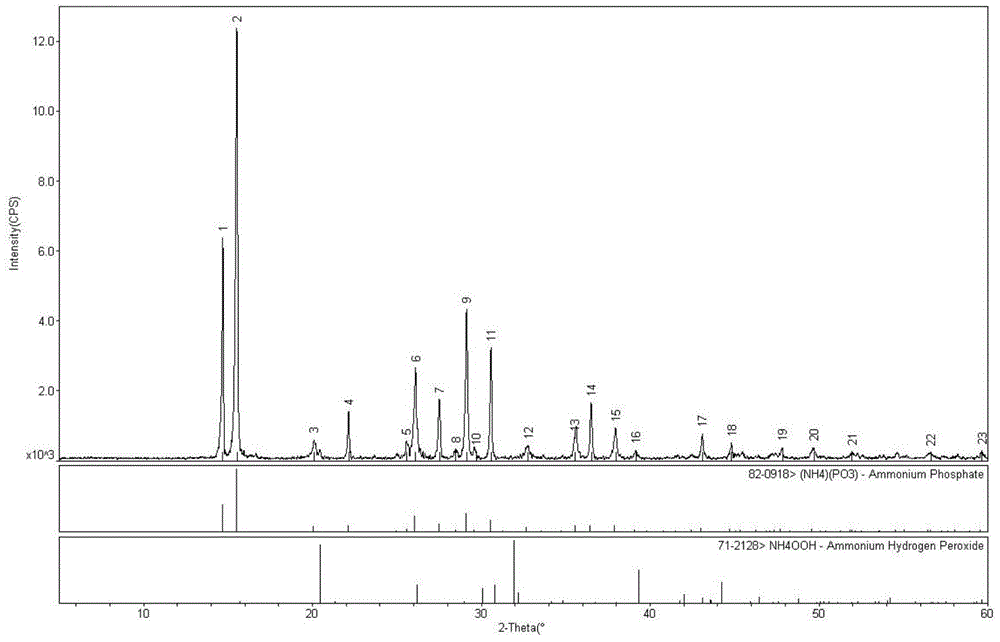A method for synthesizing crystalline type II ammonium polyphosphate by polyphosphoric acid catalysis
A polyphosphoric acid catalysis method and polyphosphoric acid catalyst technology, applied in the direction of phosphorus compounds, chemical instruments and methods, inorganic chemistry, etc., can solve problems such as easy moisture absorption, and achieve the effects of easy control of reaction conditions, improved efficiency, and stable crystal form
- Summary
- Abstract
- Description
- Claims
- Application Information
AI Technical Summary
Problems solved by technology
Method used
Image
Examples
Embodiment 1
[0020] Example 1: Using industrial-grade phosphorus pentoxide as raw material, add monoammonium phosphate and melamine for mixing. The mass ratio of industrial-grade phosphorus pentoxide, monoammonium phosphate, and melamine is 1:1:0.2, and mix the three evenly Then add to the polymerization reactor for mixing. Add reaction catalyst polyphosphoric acid in the polymerization reactor simultaneously, concentration is 110%. The mass ratio of polyphosphoric acid to the mixture in the reactor is 0.3:1. Feed the mixed gas of ammonia and nitrogen into the polymerization reactor, maintain the pressure in the reactor at 0.2-0.3 MPa, raise the temperature of the reactor to 300°C, and keep the partial pressure of the mixed gas to react for 3 hours. After the reaction is finished, cool, discharge, and crush to obtain crystalline type II ammonium polyphosphate product. During the whole reaction process, the partial pressure of ammonia was maintained at 0.2-0.3 MPa, and the flow rate was 1...
Embodiment 2
[0021] Example 2: Using industrial-grade phosphorus pentoxide as raw material, add monoammonium phosphate and melamine for mixing. The mass ratio of industrial-grade phosphorus pentoxide, monoammonium phosphate, and melamine is 1:1.2:0.3, and mix the three evenly Then add to the polymerization reactor for mixing. Add reaction catalyst polyphosphoric acid in the polymerization reactor simultaneously, concentration is 95%. The mass ratio of polyphosphoric acid to the mixture in the reactor is 0.5:1. Feed the mixed gas of ammonia and nitrogen into the polymerization reactor, maintain the pressure in the reactor at 0.3-0.4 MPa, raise the temperature of the reactor to 320°C, and keep the partial pressure of the mixed gas to react for 2 hours. After the reaction is finished, cool, discharge, and crush to obtain crystalline type II ammonium polyphosphate product. During the whole reaction process, the partial pressure of ammonia was maintained at 0.3-0.4 MPa, and the flow rate was ...
Embodiment 3
[0022] Example 3: Using industrial-grade phosphorus pentoxide as a raw material, add monoammonium phosphate and melamine for mixing. The mass ratio of industrial-grade phosphorus pentoxide, monoammonium phosphate, and melamine is 1:1.5:0.5, and mix the three evenly Then add to the polymerization reactor for mixing. Add reaction catalyst polyphosphoric acid in the polymerization reactor simultaneously, concentration is 105%. The mass ratio of polyphosphoric acid to the mixture in the reactor is 0.35:1. Feed the mixed gas of ammonia and nitrogen into the polymerization reactor, maintain the pressure in the reactor at 0.15-0.2MPa, raise the temperature of the reactor to 340°C, and keep the partial pressure of the mixed gas to react for 4 hours. After the reaction is finished, cool, discharge, and crush to obtain crystalline type II ammonium polyphosphate product. During the whole reaction process, the partial pressure of ammonia was maintained at 0.15-0.2 MPa, and the flow rate...
PUM
 Login to View More
Login to View More Abstract
Description
Claims
Application Information
 Login to View More
Login to View More - R&D
- Intellectual Property
- Life Sciences
- Materials
- Tech Scout
- Unparalleled Data Quality
- Higher Quality Content
- 60% Fewer Hallucinations
Browse by: Latest US Patents, China's latest patents, Technical Efficacy Thesaurus, Application Domain, Technology Topic, Popular Technical Reports.
© 2025 PatSnap. All rights reserved.Legal|Privacy policy|Modern Slavery Act Transparency Statement|Sitemap|About US| Contact US: help@patsnap.com


